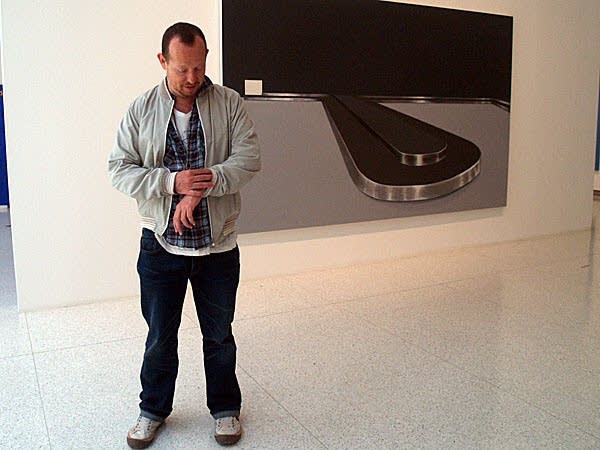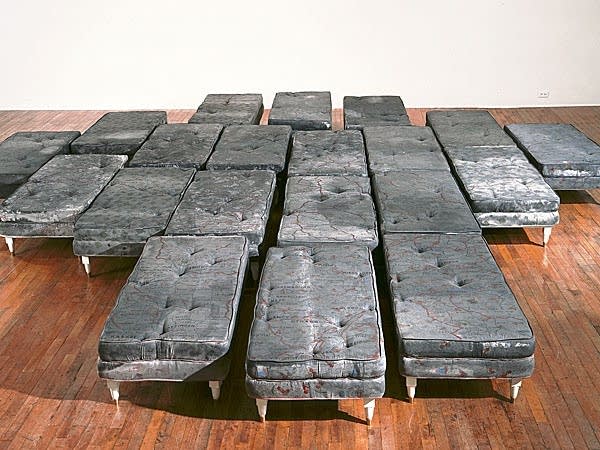Once upon a mattress - Kuitca style
Go Deeper.
Create an account or log in to save stories.
Like this?
Thanks for liking this story! We have added it to a list of your favorite stories.

For a painter who explores the human condition there are remarkably few people in Guillermo Kuitca's work. Instead he paints maps, theater seating plans, and baggage conveyers. His pieces are in collections around the world.
A huge exhibit featuring the Argentinean artist opens this weekend at the Walker Art Center in Minneapolis. Kuitca attracts attention because of his skills with a brush and his use of an unusual surface.
It's not often you see mattresses hanging on a wall, much less mattresses painted with detailed maps. But walk through "Everything" the new exhibit which covers 30 years of work by the Buenos Aires based painter, and they are everywhere. In fact as Kuitca points out, one of them even looks very familiar - or does it?
"You'll see that right in the middle it reads clearly 'Minneapolis and St. Paul,'" he grins.
Turn Up Your Support
MPR News helps you turn down the noise and build shared understanding. Turn up your support for this public resource and keep trusted journalism accessible to all.
Guillermo Kuitca likes to paint on mattresses because of what happens on them.
"Dreams, sex, death, life. It's just this rectangle with four legs, and yet that embraces an incredible amount of human experiences. And so it's almost like a perfect equation of having achieved so much with so little," he says.
And by covering his mattresses with maps Kutica explores the need and desire to know where we are in the world.

"Sometimes it is a sense of location," he says. "But sometimes it is right the opposite, right where we are not."
Listening intently is Walker Director Olga Viso. She's worked with Kuitca since the early 1990's, and started assembling this exhibit when she was at the Hirschhorn in Washington, D.C. She says it's important to remember maps are abstractions.
"It's one of many mechanisms that we use to try to describe and understand the world that we live in," she says. "And I think throughout his career Guillermo's been interested in those different mechanisms that we as humans use to try to grasp our world, our relationship to it, our relationship one to the other."
Which brings us back to the map of Minneapolis-St. Paul. It's the center piece in a triptych. The mattress on the left depicts Oklahoma. The one on the right someplace along the Iowa-Missouri line.
They line up in a way a mapmaker would see as inaccurate. But there is a large pink stain spreading across all three which clearly links them. It raises many questions, including is this the place we know? Or some other Minnesota?
Kuitca says when he did the piece in 1990 in Buenos Aires he was looking to paint some place exotic.
"Most of the maps that I was depicting at that time were places that were particularly unfamiliar," he says.
He never dreamed it might ever be shown here.
Few people describe themselves as simply as painters nowadays. In fact as Kuitca began his career three decades ago many art critics were declaring painting was dead.

The Walker's Olga Viso says Kuitca has constantly explored his medium.
"He's, throughout his career, sort of taken upon himself that challenge of trying to paint without previous reference, and certainly previous reference to the history of painting, to the history of art," she says.
When, early in his career, Kuitca was drawn to the theater for inspiration, he didn't paint moments on stage, but seating plans. He says he wanted to turn the audience experience back on itself. Some are straightforward depictions, but later works have the plans smearing off into oblivion or even exploding.
In recent years he's been drawn to painting luggage carousels. He sees them as another place of drama.
"It's a funny object because we always find ourselves in front of a luggage carousel a little bit out of place, a little bit lost, without knowing where we are," he says.
Kuitca captures the sense of displacement many long-haul travelers feel.

He has a way with detail which is startling. Many of his paintings are quite large -- even those not on mattresses. Yet images which appear to be one thing from afar can be very different close up. Olga Viso says points to the final piece in the show, a picture from which the exhibit takes its name, "Everything."
"From a distance you read it like this neural network, or fingerprints across this black canvas," she says. "And when you come up close to it you begin to discern that it's a map with names of cities and places and highways in this very dense construction, so you have two very different experiences with the work."
Viso will interview Kuitca on Saturday afternoon as part of the opening of the show.
Guillermo Kuitca says he never knows how people will react to his work, but he is always pleased when people pause to have what he calls a private moment with something he has created.
"When that happens that makes the whole thing worth it, actually," he says.
Kuitca then returns to finishing the installation. He's not seen many of these pieces in the same show, and he's enjoying how well they work together.
Dear reader,
Your voice matters. And we want to hear it.
Will you help shape the future of Minnesota Public Radio by taking our short Listener Survey?
It only takes a few minutes, and your input helps us serve you better—whether it’s news, culture, or the conversations that matter most to Minnesotans.




